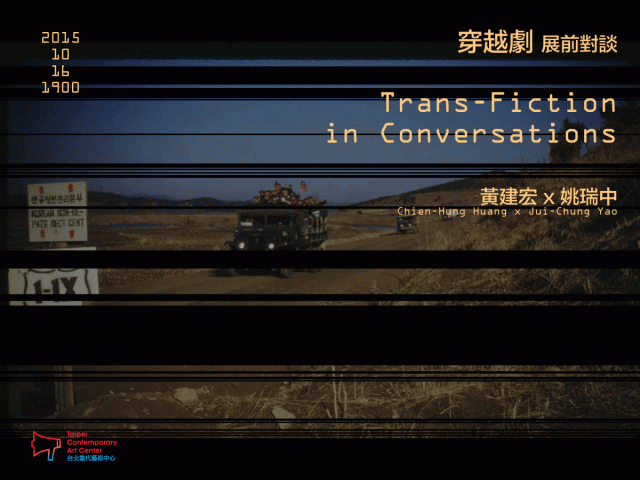For English please scroll down
時間:2015. 10. 16, 7pm
地點:台北當代藝術中心,台北市保安街49巷11號(捷運大橋頭站)
對談者:黃建宏、姚瑞中
由黃建宏策劃的《穿越劇:在台灣各階段生命政治與運動的檔案文件史》即將於11月25日於韓國光州ACC開幕展出,行前特別邀請其中參展藝術家姚瑞中來進行對談介紹展覽核心思維,試圖勾勒出在地藝術檔案的圖像,對台灣藝術事件的檔案問題、亞洲的想像和實踐以及檔案的重要性,提出延伸性的思考線索。
展覽《穿越劇:在台灣各階段生命政治與運動的檔案文件史》直視生命政治下的微建檔(micro-archiving)命題。檔案是書寫歷史的框架,因此「缺乏檔案」或是「無法形成檔案」也意味著歷史的欠缺或斷裂;而後者正是目前東亞地區的現況。因此「如何在亞洲形塑檔案?」就成為一個巨大的挑戰,我們面對許多不同脈絡中顯得異質的材料,而這些材料甚至從來沒有過明確的整理或分類。除此之外,我們也不能只是跟隨20世紀60年代以來便不斷遭受批判的歐美檔案系統。我們必須透過批判性的思考來收集歷史的元素和素材。這就是為何我們將這計畫稱為穿越劇計畫,我們透過生產意義來蒐集材料,反之亦然。這個計畫的方法會以「生命政治」、「歷史書寫法」和「運動之後」三個部分組成。
歷史書寫法是這次研究工作中的重點之一,也是最直接與台灣長期狀況有關的面相, 我們特別關注到的是小型與網絡性強的「檔案」行動,這些檔案行動並非直接地指向制式的「建檔」,相對地,在檔案匱乏的狀態下生成對於制式建檔的不同批判性態度。這個部分主要選擇三種類型來展示這種批判性的歷史書寫:一個是關於空間(伊通)、另外一個關於出版(ACT)、以及個人(姚瑞中)的私藏。
其中姚瑞中進行的是一種藝術家個人旨趣的「收集」,若嚴格來說,他的收藏範圍與界定僅能以他自身在藝術範疇中的網絡來理解,與以展覽和藝術家為主軸的伊通公園,以及以專題規劃、訪問與編輯來構思和生產檔案的方式都不同,除此之外,他的無差別收藏相對地卻含納了許多的線索,可以說他的檔案處於一種渾沌狀態。這個渾沌世界主要包含幾個「群」,一是藝術家自身創作的資料、二是個別藝術家在二十年的跨度中有著甚麼樣的變化、三是相關藝術主題和展演型態的發展、四是藝術運動的資料、五是可以發現相關實驗性出版品的線索。我們特別選取了這些文件中與實驗性藝術運動較有關係的部分,主要有地下運動、另類空間、展覽主題、藝術事件、藝術計畫等部分。這部分還需要相當的調研來確認並補足建檔的工作,無疑地,因為藝術家自身的開放性與特異性,而保存了相當具有潛力的文件和資料。
Time: 2015. 10. 16, 7pm
Venue: Taipei Contemporary Art Center, No. 11, Lane 49, Baoan Street, Taipei (MRT Daqiaotou Station)
Speakers: Chien-Hung Huang, Jui-Chung Yao
Curated by Chieh-Hung Huang, the archive exhibition Trans-Fiction is going to be presented in the Asia Culture Complex, Guangju in 25 November. This talk attempts to illustrate the problematic of the local art archive in conversation with one of the participating artists Jui-Chung Yao as an introduction to the exhibition concept, and extend more possibilities to reflect on the Taiwanese art archive in relation to the imagination and practice in Asia as well as the importance of archive per se.
Trans-fiction: Archival History of Bio-politics and Social Movements from Taiwan investigates the question of “micro-archiving.” Archive is the conceptual framing of historicity. Therefore, the lack of archive, or the inability to archive could be translated into the missing or rupture of history. The latter actually describes the current status in East Asia. “How to archive” is therefore an enormous task as we confront with nuanced materials of various contexts that have never been classified and filed. Apart from it, it is inadequate to follow the Western archive system that has been criticized since the 60s in the last century. There is a need to generate criticality for collecting historical materials. Based on these parameters, the project is titled as Trans-Fiction to collect materials through their production meanings. This project is composed of three sections: Bio-politics, Historiography and POST-movement.
Deeply tied to the long-term situation in Taiwan, historiography is one of the focuses in this research. This project takes a specific interest in the small-scale and network-based archiving actions. Instead of being the traditional archive, they embody a different criticism to the lack of archive. Three selected cases will present such critical historiography: one is about space (IT Park), one concerns publication (ACT), and the last one takes a personal stance (Jui-Chung Yao).
Yao’s archive collection is based on the artist’s personal interest, and could be understood as generated from his personal art network. It is different from IT Park’s focus on exhibitions and artists, or ACT’s editorial features. However, his archive conveys many complex clues in chaos that include a few kinds of clusters: 1) his personal references for art practice, 2) the changes and transformations of individual artists in the past 20 years, 3) the trajectory of subjects and forms of exhibition/performance, 4) data about art movements, 5) clues leading to relevant experimental publications. The exhibition presents documents related to experimental art movements about underground movement, alternative space, exhibition themes, art events, art projects, etc. Lots of research will need to be conducted to identify and complete the archive. Undoubtedly, the openness and specificity of this artist collection sustains a potential treasure of documents and materials.

